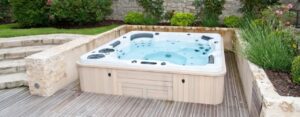October 16, 2024
Category: Hot Tub
You might be looking forward to a relaxing soak after a long day or planning a cosy gathering with friends, but waiting for your hot tub to reach the perfect temperature can feel like an eternity. Do hot tubs take time to heat up? The short answer is yes, but there’s more to it than that.
Several elements play a role in how quickly your hot tub can reach the desired temperature. Let’s take a closer look at the most significant factors:
1. Size and Volume
Larger hot tubs contain more water, which means it will take longer to heat up compared to a smaller model. The volume of water directly impacts the heating time, so if you have a bigger tub, be prepared to wait a little longer.
2. Initial Water Temperature
If your hot tub starts off with cold water, it will naturally take more time to heat up. For example, filling your hot tub with water from the garden hose in winter can mean a much longer wait compared to using warm water or heating during warmer months.
3. Ambient Temperature
The surrounding air temperature plays a crucial role in heating time. If it’s cold outside, your hot tub will take longer to heat up. Conversely, warmer weather can help the water reach the desired temperature more quickly.
4. Insulation Quality
The better the insulation, the less heat escapes, and the faster your hot tub can heat up. High-quality, well-insulated models like a Hydropool hot tub retain heat more efficiently, reducing both heating time and energy costs.
5. Heater Capacity:
The power of your hot tub’s heater is a major factor. Most hot tubs are equipped with heaters ranging from 1.5 kW to 5.5 kW. A higher capacity heater can warm the water faster, but it may also consume more energy.
6. Cover Usage
Using a high-quality cover is essential to retaining heat. An uncovered hot tub loses heat rapidly, especially in colder climates. Make sure your cover fits well and is in good condition to keep the warmth inside.
7. Jets and Water Circulation
Activating jets while heating can actually slow down the process because moving water cools more quickly. Keep the jets off until your hot tub reaches the desired temperature for faster heating.
How Long Does It Take for a Hydropool Hot Tub to Heat Up?
On average, a hot tub heats up by about 1-3 degrees Celsius per hour, depending on the factors mentioned above. So, if you’re starting with water at 10°C and want to reach a relaxing 38°C, you’re looking at around 4-12 hours of heating time. Fortunately, a Hydropool hot tub is designed with efficiency in mind, featuring powerful heaters and excellent insulation that can significantly reduce this waiting period.
Tips to Make Your Hot Tub Heat Up Faster
If you’re eager to jump in and don’t want to wait, there are several tricks you can use to speed up the heating process:
- Keep the Cover On
Always keep the cover on while your hot tub is heating up. This traps the heat inside and prevents the cold air from cooling the water down. Make sure the cover is properly fitted and in good condition to maximise efficiency. - Use Warm Water
If possible, fill your hot tub with warm water rather than cold. This can drastically reduce the time it takes to reach your desired temperature. However, make sure to check your hot tub manual for any restrictions on initial water temperature. - Turn Off the Jets
While it may be tempting to get the water circulating, running the jets can actually slow down the heating process. Turn them off until your hot tub is fully heated, then switch them on for the full spa experience. - Check the Heater Settings
Ensure that your hot tub’s heater is set to the maximum safe setting allowed by the manufacturer. If you’re unsure, refer to your Hydropool hot tub manual for guidance. - Improve Insulation
If you live in a particularly cold area, consider adding additional insulation around your hot tub or upgrading to a better cover. Insulation blankets can also be placed under the tub to prevent heat loss through the ground. - Keep the Wind Out
Wind can significantly reduce your hot tub’s heating efficiency. Set up a windbreak around your hot tub area, such as a fence or privacy screen, to protect against heat loss caused by strong breezes. - Regular Maintenance
Ensure that your hot tub is properly maintained. Clean filters and clear plumbing allow for optimal performance. A clogged or dirty filter can strain the system, causing the heater to work harder and take longer to heat the water.
Why Choose a Hydropool Hot Tub?
A Hydropool hot tub is specifically engineered for energy efficiency and quick heating. Here’s why it stands out:
- Self-Cleaning Technology: Hydropool’s self-cleaning feature helps maintain clear water with minimal effort, ensuring your tub runs efficiently and reducing wear on the heater.
- Superior Insulation: Designed with high-grade insulation and heat-lock technology, Hydropool hot tubs retain warmth effectively, meaning less time and energy is needed to reach the perfect temperature.
- Eco-Friendly Options: Hydropool offers energy-efficient models with eco-friendly features that lower energy consumption without sacrificing performance.
What is the Ideal Temperature for a Hydropool Hot Tub?
Most users find a water temperature between 38°C and 40°C to be ideal for a relaxing soak. However, the right temperature for you depends on your personal preference and comfort level. It’s also worth noting that prolonged exposure to temperatures above 40°C can be unsafe, so always follow safety guidelines.
The Wait is Worth It
Yes, hot tubs do take time to heat up, but with the right preparation and a few helpful tips, you can minimise the wait and maximise your enjoyment. Whether you’re using a Hydropool hot tub or any other brand, the key is to be patient and let your spa reach the perfect temperature for a truly relaxing experience.
If you’re considering purchasing a hot tub, a Hydropool hot tub offers a fantastic combination of energy efficiency, quick heating, and luxurious features. So, explore our range and find the perfect model to suit your needs!


